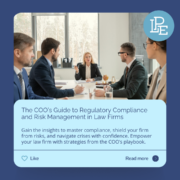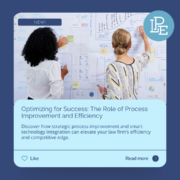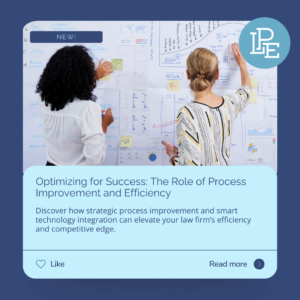In the intricate web of legal practice, where firms navigate through a maze of regulations and standards, the role of the Chief Operating Officer (COO) in ensuring compliance and managing risks cannot be overstated. As the legal industry faces increasing scrutiny and the stakes of non-compliance grow higher, the COO’s vigilance and strategic foresight play a pivotal role in safeguarding the firm’s reputation, operational integrity, and financial health.
Ensuring Compliance with Legal Standards and Regulations
The COO, often acting as the firm’s compliance officer, is charged with the comprehensive understanding of the legal and regulatory environment in which the firm operates. This involves:
- Staying Ahead of Regulatory Changes: The COO ensures the firm remains proactive in its compliance efforts by keeping abreast of new regulations, standards, and best practices. This ongoing vigilance helps the firm adapt to changes swiftly, mitigating the risk of non-compliance.
- Developing and Implementing Compliance Policies: Beyond understanding regulations, the COO is responsible for translating these requirements into actionable policies and procedures. This includes creating clear, accessible compliance guidelines for all members of the firm, conducting regular training sessions, and establishing mechanisms for monitoring and enforcing compliance.
Ensuring Optimal Insurance Protection
Ensuring that the firm possesses adequate insurance coverage is a critical component of safeguarding the firm against potential risks and liabilities. This task falls squarely within the COO’s remit of regulatory compliance and risk management. By meticulously assessing the firm’s insurance needs and maintaining comprehensive coverage, the COO plays a pivotal role in protecting the firm’s financial stability and reputation.
- Comprehensive Risk Assessment: Conduct a thorough risk assessment to identify all potential vulnerabilities the firm might face, including professional liability, cyber threats, property damage, and employment practices liability. Understanding the specific risks inherent to the firm’s operations and legal services is the first step in determining the types and levels of insurance coverage required.
- Collaboration with Insurance Brokers and Legal Experts: Work closely with insurance brokers and legal experts who specialize in the legal industry to ensure that the firm’s insurance policies are tailored to its specific needs. These professionals can provide valuable insights into emerging risks and recommend specialized insurance products that may not be widely known.
- Regular Review and Update of Insurance Policies: The legal landscape and the firm’s operations can evolve rapidly, necessitating regular reviews of insurance coverage to ensure it remains adequate and relevant. The COO should establish a schedule for annual or bi-annual reviews of all insurance policies, adjusting as necessary to reflect changes in the firm’s size, scope of services, geographic presence, and the external risk environment.
- Educating Staff on Insurance Protocols: Ensure that attorneys and staff are aware of the firm’s insurance policies, particularly those aspects that pertain to their work, such as professional liability and cyber insurance. Training sessions can help staff understand how to mitigate risks and what steps to take in the event of a potential claim or breach.
- Implementing Best Practices for Risk Mitigation: Beyond securing insurance coverage, the COO should lead the implementation of best practices and internal controls to mitigate risks. This could include cybersecurity protocols, client data protection measures, and compliance training programs. Reducing the likelihood of claims not only protects the firm but can also lead to more favorable insurance premiums.
- Communicating with Stakeholders: In the case of an incident that triggers an insurance claim, the COO should oversee the communication strategy with stakeholders, including clients, staff, and the media, as appropriate. Clear, transparent communication can help manage expectations and maintain trust during challenging times.
By ensuring the firm has adequate insurance coverages and by implementing a proactive approach to risk management, the COO not only protects the firm from potential financial losses but also contributes to the firm’s long-term resilience and success. This comprehensive approach to safeguarding the firm underscores the COO’s critical role in navigating the complexities of regulatory compliance and risk management.
Developing Policies and Procedures to Manage Risks
Risk management is an essential component of the COO’s role, involving the identification, assessment, and mitigation of risks that could impact the firm’s operations, financial standing, or reputation. Key elements include:
- Comprehensive Risk Assessments: Through regular risk assessments, the COO identifies potential vulnerabilities within the firm, from data security breaches to conflicts of interest. This holistic approach ensures that all conceivable risks are accounted for and addressed.
- Tailored Risk Management Strategies: Based on the findings of risk assessments, the COO develops and implements targeted strategies to mitigate identified risks. This could involve enhancing cybersecurity measures, improving client data protection protocols, or revising conflict-of-interest policies.
The Importance of Crisis Management and Contingency Planning
Despite the most meticulous planning, unexpected crises can arise, demanding immediate and effective response. The COO’s role in crisis management and contingency planning is critical in ensuring the firm’s resilience. This responsibility entails:
- Establishing Crisis Management Protocols: The COO devises comprehensive crisis management plans, outlining the steps to be taken in response to various scenarios. This proactive approach ensures that the firm can act swiftly and decisively to mitigate the impacts of a crisis.
- Training and Preparedness: Equally important is the training of staff in crisis response and the regular testing of crisis management plans through drills and simulations. This preparedness empowers the firm to navigate crises with minimal disruption to operations and client services.
- Contingency Planning: Beyond immediate crisis response, the COO develops contingency plans to secure the firm’s long-term recovery and sustainability. This includes planning for business continuity, data recovery, and communication strategies to maintain trust with clients and stakeholders.
Conclusion
The COO’s role in regulatory compliance and risk management is a cornerstone of a law firm’s stability and success. Through diligent oversight, strategic planning, and proactive crisis management, the COO ensures that the firm not only meets its legal obligations but also stands prepared to face potential crises with resilience. This comprehensive approach to compliance and risk management not only protects the firm from potential legal and financial repercussions but also reinforces its reputation for integrity and reliability in the eyes of clients, regulators, and the broader legal community. By embodying these responsibilities, the COO plays a critical role in safeguarding the firm’s present and future, ensuring that it remains on a steady course towards growth and success in an ever-evolving legal landscape.










